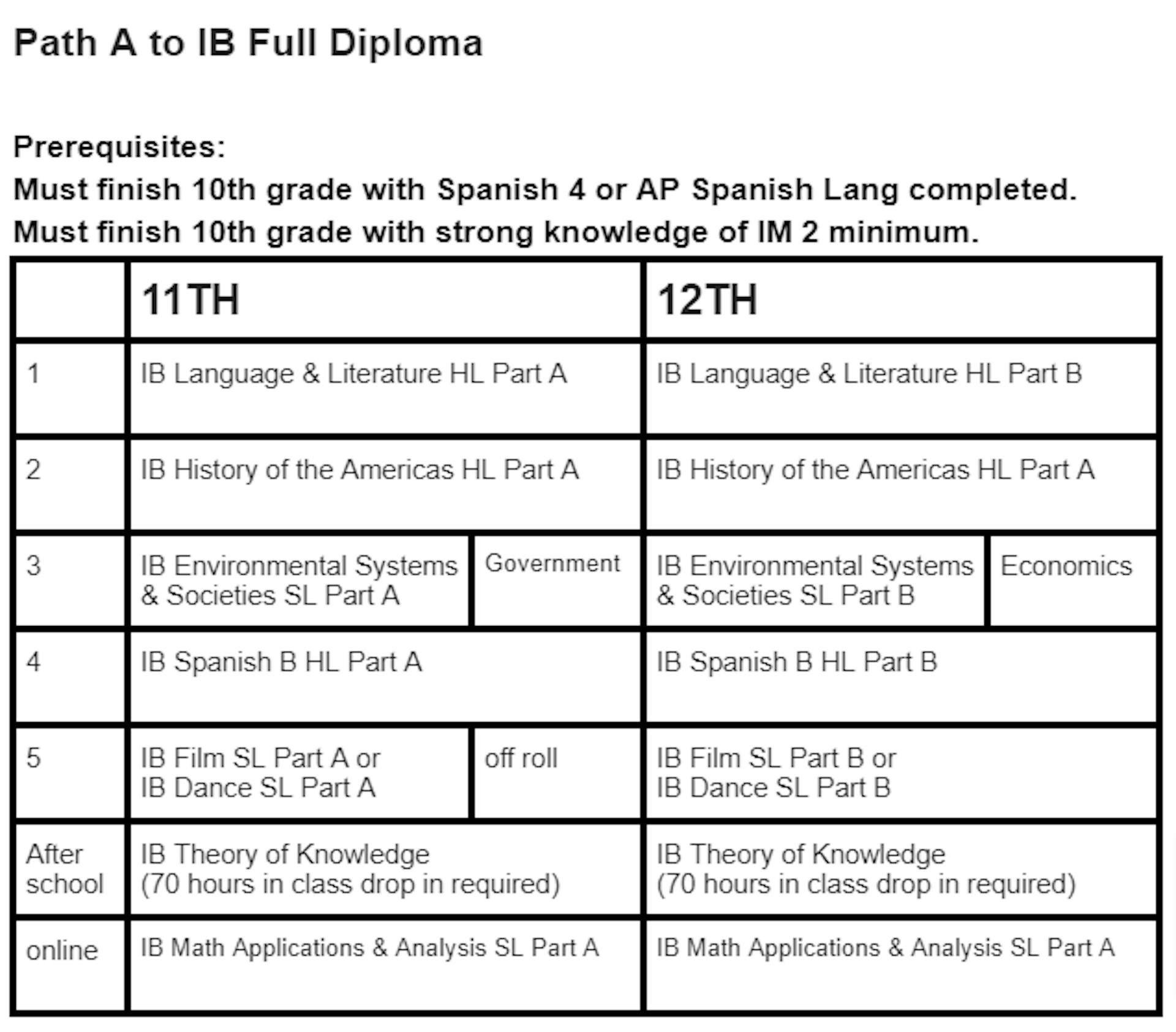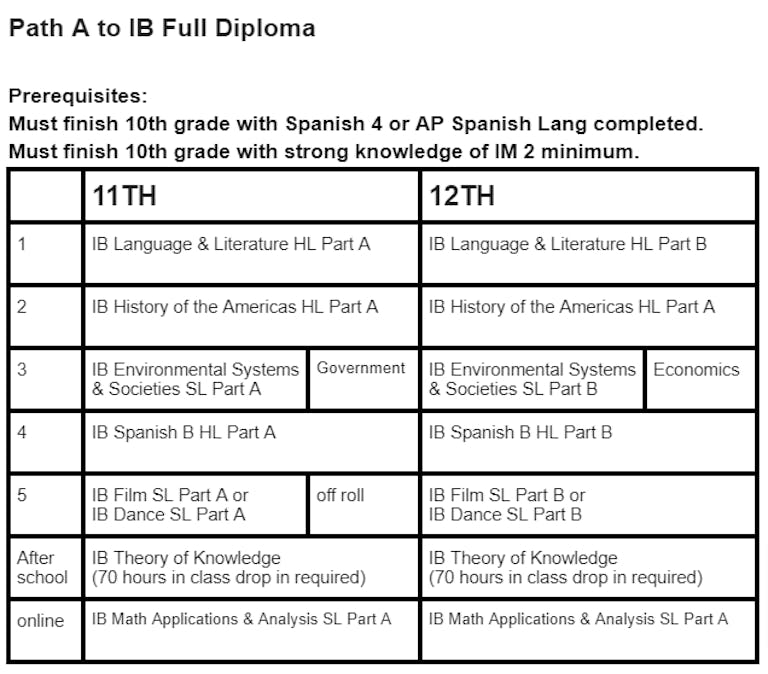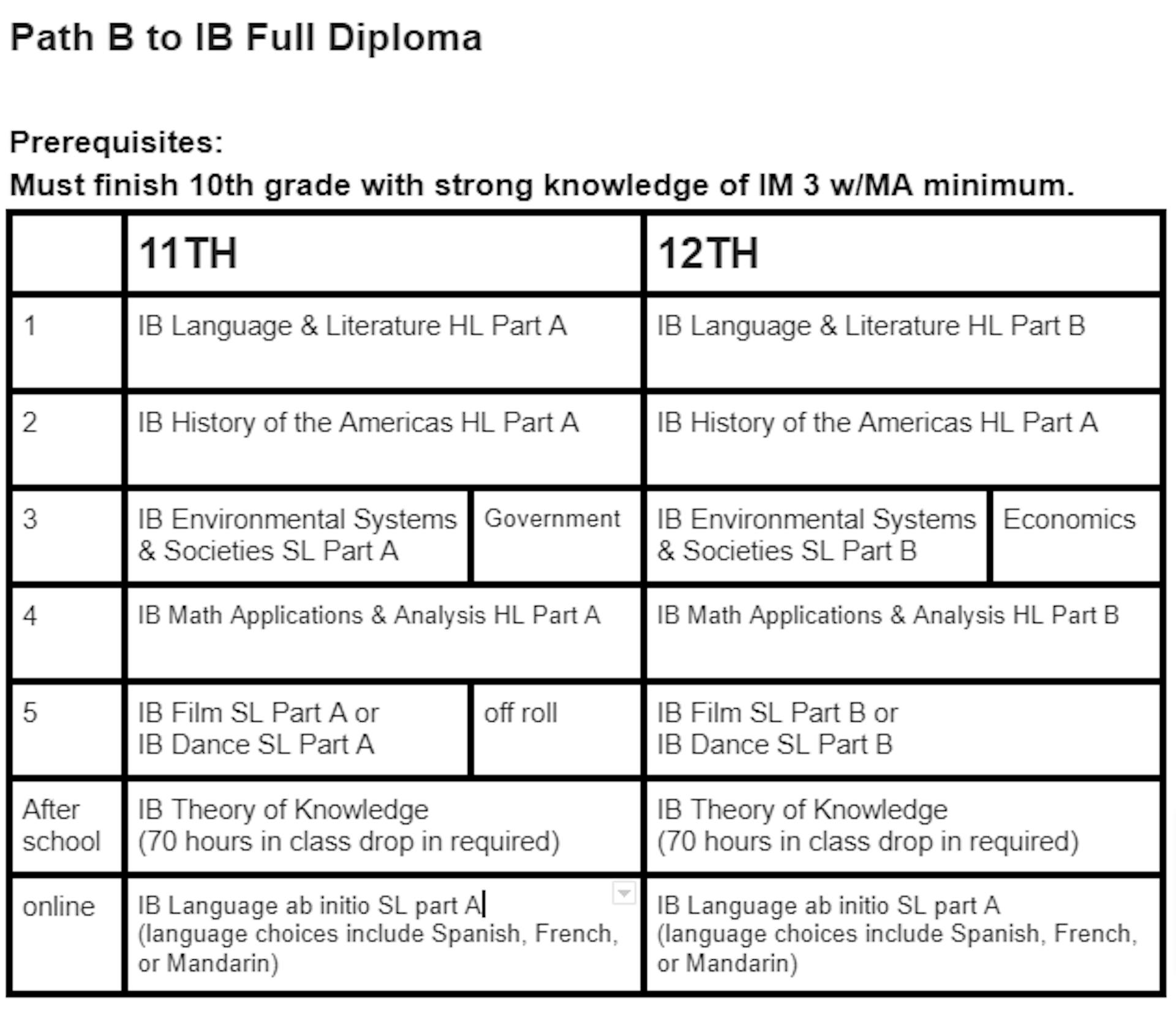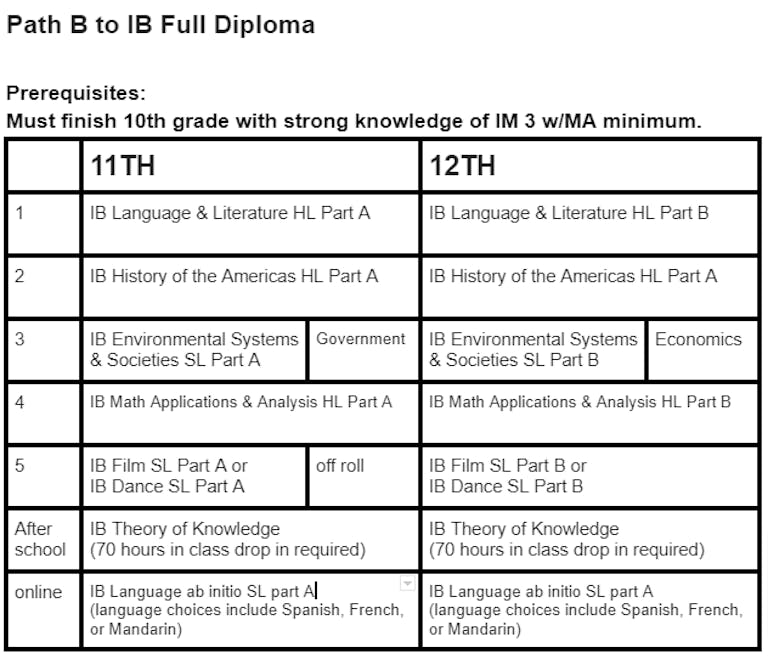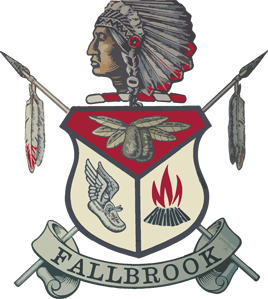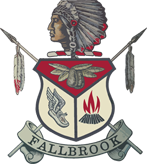The IB Programme
IB DP (Diploma Programme)
The IB DP (Diploma Programme)
Featuring a rigorous integrated curriculum, the prestigious International Baccalaureate Diploma develops critical thinking, global perspective, college writing and research ability.
The International Baccalaureate Diploma Programme (IB DP) is recognized around the world for its challenging curriculum and is welcomed by top universities.
Students learn more than a collection of facts. The Diploma Programme prepares students for university and encourages them to:
- ask challenging questions
- learn how to learn
- develop a strong sense of their own identity and culture
- develop the ability to communicate with and understand people from other countries and cultures.
The IB Bilingual Diploma
A student can receive the IB Bilingual Diploma if, as part of their full diploma programme, they select the following classes:
1) IB Spanish B HL (parts A & B)
2) IB Environmental Systems and Societies (in Spanish) (parts A and B)
The IB Diploma = More Competitive at Top Universities
The IB Diploma Programme Explained

The 4 Components
- The courses begin in 11th grade
- 3 courses can be SL
- 3 courses must be HL
- The courses must represent the 6 groups of knowledge, which include
- Language and Literature
- Language Acquisition
- Individuals and Societies
- Experimental Sciences
- Mathematics
- The Arts
Theory of Knowledge (TOK)
TOK is a two year course that begins in the second semester of 11th grade, meeting from 3:30 to 5:00 every Tuesday and Thursday, and first semester of 12th grade, meeting from 3:30 to 5:00 every Tuesday and Thursday.
TOK has been designed to develop skills that will help you investigate the origin and reliability of the knowledge you have acquired. It explores how you, the individual or knower, utilizes emotions, reason, language, and sense perception to come to know what you know.
In this course you will explore how you have come to know what you know in the areas of the Natural Sciences, Human Sciences, History, Arts, Ethics, and Mathematics. You will be asked to scrutinize your knowledge by comparing the ways of knowing and knowledge claims across disciplines, and by becoming aware of how personal and cultural views impact the knowing process for yourself and for others.
This course will include preparation for the IB Extended Essay and IB CAS documentation.
The Extended Essay (EE)
The Extended Essay is a core component of the International Baccalaureate Diploma Programme, and is mandatory for all students getting the full diploma, regardless of the subjects they are taking.
The aim of the EE is to provide students with the opportunity to research a topic of their interest, and showcase their knowledge and reading beyond the classroom syllabus. The essay also enables students to acquire some of the skills that are essential for researching and writing university Bachelor and Master theses.
Students start working on their essay in the second term of the first year of their IB Diploma Programme, around January.
The EE should be no longer than 4000 words, with a short viva voce at the end. The process takes around a year.
Select a Supervisor
Students will need a supervisor (usually one of the teachers at their school), who will meet regularly with them to help structure their research questions and guide them in writing the paper. The programme allows for one draft to be handed in to the supervisor for feedback, and then the second version is the final version.
Choose a Topic
The topic must be related to one of the six topics that the student is taking for their Diploma, or they can take an interdisciplinary ‘world studies’ issue that relates to two of their subjects. This requires that a global issue to be looked at through a local lens, for example how wider climate change, cultural, terrorism, technology or health trends are manifested in a specific context or place.
It is generally best for students to choose a topic that they are passionate about, not least because they will have to work on it for a year!
The topic needs to be approved by the IBO, which the school will help with.
Choose a Research Question
Once students have chosen their topic, they need to decide on a research question. A wrongly formulated research question will turn this learning experience into a stressful one. It is essential that the question is relevant, focused, that the answer is not a simple yes or no, but also that it is actually answerable. It is not necessary to prove the research question right – disagreeing with the initial hypothesis is perfectly fine. Questions will fall broadly into two categories: either they will be aimed at solving a problem, for example, through conducting an experiment; or they will lead to a research or study around the topic.
The question should not necessarily start with words like, ‘Does’, ‘Will’ or ‘Is’. To come to a meaningful conclusion, simply stating that ‘yes, it is true’ or ‘no, it is not true’ is insufficient. For this reason the highest scoring essays usually have a research question that start with, ‘To what extent’, ‘A study of’, ‘An analysis of’, or ‘How far’, or could even just be a statement to analyze.
Investigating, Analyzing, and Writing
Once the research question has been set and tested, it’s time to start collecting primary and secondary data. Keeping a log of the data is a good idea. The results of the research can be put in an appendix and, where appropriate, referred to in the text. In the essay itself the data can be summarised in charts and tables.
Once all the data has been collected, it can be analysed. The outcomes of this should be evaluated against relevant concepts and reading in the chosen subject. It’s a good idea to write out the arguments, structure, and headings before beginning writing so the essay is presented clearly and logically, using any terminology correctly.
Introduction and Conclusion
A rough draft of the introduction can be written at an early stage. After having collected, analyzed, and evaluated the data, the introduction can be adjusted to fit the essay. The introduction should explain why the research question is worth investigating, and how it relates to the subject, in other words, it should set the academic context for the essay.
The conclusion should be written at the end, and should not include any additional research or analysis. It should summarize what has already been stated. Examiners carefully look at this.
The Abstract
Abstracts were invented so that people who wanted to further research the topic could quickly learn if this essay would be valuable for their research. At the end of writing, the student needs to write the abstract, which is a 300-word summary of the essay. It should include the research question, a very short summary of the analysis and the answer to the research question.
Other Elements of the Extended Essay
Students also need a title page, contents page, references, bibliography, and any appendices (for example, containing any data). All of these things must be included in the word limit.
Deadlines
Year 1
December: Introduce EE to students
January: Submit research proposal
February: Supervisor Assigned
February: First meeting with Supervisory (in TOK class)
March: Reflective Session #1 w/Supervisor (in TOK class)
May: 3rd Meeting with Supervisor (in TOK class)
May: Benchmark: first 1,500 words complete
June: 4th Meeting with Supervisor (in TOK class)
Year 2
August: Benchmark: first 3,000 words complete
August: Reflective Session #2 with Supervisor (in TOK class)
September: FIRST FULL DRAFT DUE
October: Feedback session with Supervisor (notes on draft) (in TOK class)
November: FINAL DRAFTS DUE AND UPLOADED TO IBO FOR GRADING
December: Viva Voce Session with Supervisor (in TOK class)
Viva Voce
The viva voce is essentially a short interview with the supervisor, in which they ask students to reflect on the strengths and successes of their findings, as well as looking at any areas that caused unexpected problems, and what can be learned from the research report. It’s nothing to worry about – it’s just something that can be greatly enhanced with preparation and thinking beforehand. They are also making sure that the report hasn’t been plagiarized!
What is CAS?
Creativity, Activity, Service (CAS) is a core part of the IB Diploma and provides an excellent structure for the co-curricular and community service elements of life at Fallbrook, as well as supporting our mission to develop the whole person. Students getting the IB Diploma need to complete 150 CAS hours. Hours cannot be logged until the beginning of their 11th grade year. The CAS programme offers opportunities for students to develop their teamwork, leadership and communication skills. The purpose of CAS is for students to get involved in a broad range of activities that work as a compliment to their academic studies. The three strands of CAS, which are often interwoven with particular activities, are characterized as follows.
Creativity
Creativity, for many students will include photography, design, art or music. There are a multitude of opportunities to develop creative skills. Whether you are making videos to promote Earth Day or learning to play the ukulele as part of a study of protest music in the 1960s, students can get involved in a wide array of creative pursuits that relate to their academic core classes.
Activity
Activity involves physical activity. It can be an individual or a team activity and could include surfing, working out at the gym, or participating in a sport such as tennis, football, rugby, basketball or dance. These activities are focused on achieving a personal goal and are often connected to math and science as you develop methods to improve your overall performance.
Service
Service activities might include working in a local charity shop, teaching younger kids how to play tennis, fundraising for charity, speaking out as an advocate on an issue in a public government forum, or gaining first aid qualifications. Students will devote a larger chunk of time in year two on a service project which will then be presented to the public.
CAS Timeline
Year 1
- August: CAS Introduction
- August: 1st Interview with CAS Coordinator
- August: Complete Background Information Form
- August: Fill out Activity Proposal Map
- September: 2nd Interview with CAS Coordinator
- September: undertake activities, collect evidence, write reflections (ongoing)September: 3rd Interview with CAS Coordinator (begin monthly) October: 4th Interview with CAS Coordinator
- November: 5th Interview with CAS Coordinator
- December: Deadline: Turn in CAS handbook with reflections
- January: CAS work shifts into TOK class. monthly reviews shift to TOK teacher
- January: 6th Interview
- February: 7th Interview
- March: 8th Interview
- April: 9th Interview
- April: Deadline: Turn in CAS handbook with reflections
- April: Make plans for any summer CAS work
Year 2
- August: 10th Interview
- August: Propose larger Service project ideas
- September: Begin larger service project
- September: 11th interview
- October: 12th Interview
- November: Deadline: Turn in CAS handbook with reflections (150 hours complete here) December: CAS Presentation night end of TOK course.
Adding it Up: How You Earn the IB Diploma

4 Year Map
